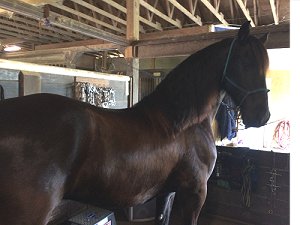 There are many reasons why a horse is stalled. Most of them are fallacious. (based on a mistaken belief. synonyms: erroneous, false, untrue, wrong, incorrect, flawed, inaccurate, mistaken, misinformed, misguided).
There are many reasons why a horse is stalled. Most of them are fallacious. (based on a mistaken belief. synonyms: erroneous, false, untrue, wrong, incorrect, flawed, inaccurate, mistaken, misinformed, misguided).
Horses are herd animals. They experience psychological insecurity when removed or isolated from other herd members. This can lead to instability of temperament and the development of coping behaviors to channel the nervousness that ensues when they are removed from their instinctive need to group with their own. While they will take a surrogate (a donkey, goat or a herd of cows), their social nature needs an outlet.
They also have a need to travel – continually walking, moving, grazing, meandering. They rarely lie down. Wild horses and free-pastured horses travel as much as 10 miles a day or more. Because their circulatory system demands a lot of muscle contraction from the lower extremities as well as the heart, walking keeps the blood flowing up the leg and throughout the body proper. Blood located in the digital cushion of the hoof just above the frog is compressed with each step and pumped back up the leg, actually aiding the heart in moving blood. Without good blood flow in the hoof and lower leg, the flow of life-supporting blood is constricted leading to pathology in the hoof and up the leg.
See: Hoof Anatomy and a discussion of the Barefoot Horse
Stalling seems to be practiced most in certain disciplines and in certain parts of the country. In the North East where pasture is at a premium and horses are at a maximum, stalling is seen as the way to keep horses “safe” (from the elements and each other) and confined. If they are lucky, they are turned out into small paddocks during some portion of the day.
Most are routinely lunged before they are ridden “to get the pent-up crazy out”. While I frequently lunge a horse-in-training before we ride, it is to remind him that I am the leader, not to exercise until he is too tired to “feel his oats” after being kept in a small enclosure. The psychology of the lunging is completely different.
You usually find that stalled horses are shod horses – a double whammy of potential physical pathology. No life-giving blood flow from walking. No life-giving blood flow from the restricted hoof that cannot pump.
Unshod horses in small (or large) herds in large paddocks or pastures will remain both physically and psychologically healthy for many more years than restricted and shod animals.
Horse training and equestrian activities in general can be dangerous. While we try to present relevant and valuable content, under no circumstances does horse-pros.com or its members or contributors take any responsibility for the well-being of any horse or person using a method outlined here.
Please note that this advice is neither veterinary nor prescriptive in nature but offered only as an introduction to this topic.
We need your help. We certainly don’t know everything. Please share your expertise and experiences. Comment on what is already written or Suggest a Category and Educate us about it. Grow Horse-Pros.com©
